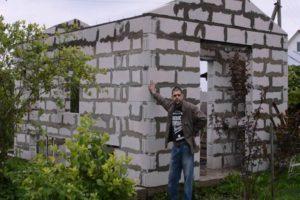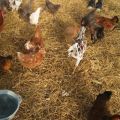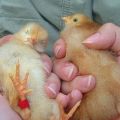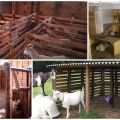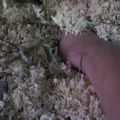Pros and cons of floors in a hen house, from what and how to do it yourself
The floor in each coop can be made of different materials. It depends on the type of material whether additional insulation is needed in the future or not. Some types of floors provide comfortable room maintenance and block the collection of waste, including chicken droppings.
Role and function of gender
Before building the floor in the birdhouse, the foundation and pillow are initially laid. After that, a covering should be made from the selected material, which will act as the floor. The floor in the hen house has the following meaning:
- keeps warm;
- a fulcrum for birds and allows them to move comfortably around the room;
- protects the paws of chickens from damage.
Also, if there is a floor in the chicken coop, it is much easier to clean and replace the litter. A properly installed floor protects birds from pests, including rodents, which can spread disease.
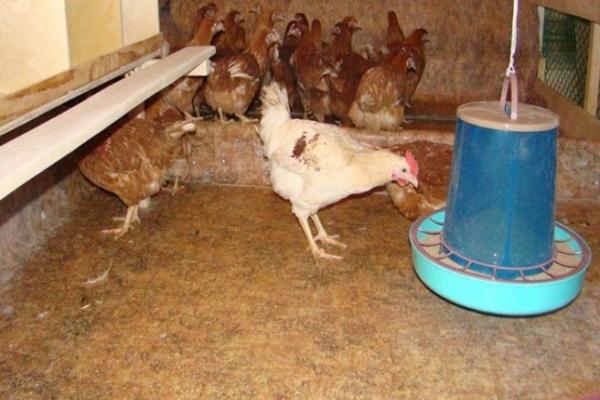
When building flooring in a chicken coop, the floor needs to meet the following criteria:
- Moisture resistant. If the structure is incorrect, the flooring allows water to pass through, which can contribute to the appearance of diseases in birds.
- Be level without pits and cracks. This criterion is necessary to maintain the safety of birds while moving indoors.
- Made of durable and safe materials - reduces the risk of toxic particles released into the air. The durability of the flooring depends on the strength of the material.
- Thermal conductivity - you need to choose a material that has low thermal conductivity. This criterion keeps warm, this aspect is important in winter.
If wood material is used, it should be carefully sanded and painted. This coating protects the tree from possible damage.

Features and types
The floor can be of different types. There are the following types of floors that can be used for a chicken coop:
- From the ground - Ground cover instead of flooring is often used in a chicken coop. To keep warm, it is often necessary to additionally use straw or sawdust bedding. This type of floor is affordable and requires no investment. However, such a coating has drawbacks, first of all, it should be attributed to the presence of harmful microorganisms and parasites that may appear at any time. Also, it is difficult to disinfect on such a floor, and it is necessary to regularly change the litter.
- Concrete - a flat surface. This coating does not allow moisture to pass through and prevents the appearance of pests and rodents.The advantage of such a coating is strength and a long period of operation.
- Wooden - the covering is made from a board. This floor is warm and does not require additional bedding. Another advantage of the floor is that it is easy to clean. Linoleum is often laid on a wooden floor. This additionally insulates the room and reduces the risk of damage to the paws of chickens during movement.
- Mesh - this type of floor is used for comfortable room maintenance. The mesh floor is designed so that all waste on the floor can accumulate in a special tray installed under the floor.
The choice of floor for the chicken coop depends on the size of the room and the type of material that will be used to build the bird housing.
The use of a concrete coating is not advisable for structures made of polycarbonate.

What is the best to make?
When choosing a material for the floor, not only personal preferences are taken into account, but also the type of room. For warmer regions, concrete floors can be used with litter. Wooden flooring has many advantages, as it retains heat well and can be easily removed from dirt.
Important. You can often find combined flooring, such devices contain both concrete and wooden surfaces. It is used most often in large chicken coops, where wooden flooring is laid in the place of perches and the location of the feeders. The rest is filled with concrete. This design makes it easier to clean the room.

How to make a floor in a chicken coop with your own hands?
In order to independently make a coating in the chicken room, it is necessary to prepare all materials and tools. The list of materials depends on the type of floor and the size of the chicken room.
Instruments
The list of tools depends on the type of floor. It is necessary to prepare the following types of tools needed for the structure:
| Wooden floor | Concrete | From the grid |
| Board | Sand | Durable mesh |
| Bars | Crushed stone | Bars |
| Nails | Cement | Nails |
| A hammer | Formwork beams | Pallet concrete |
| Saw | Saw | Sawdust |
| Cement mortar | Plate for making armor | |
| Roulette |
Additional tools may be used depending on the personal preference of the builder. A special insulating layer can be used as a heater, which also acts as a protection against moisture penetration.
Instructions
There are no specific instructions for making flooring in the chicken coop. However, you must follow some recommendations for implementation:
- A foundation must be made in the building. Flooring does not protect birds from cold and pests without a foundation.
- It is necessary to make wooden logs on the foundation.
- The floor frame is prepared from the beams.
- The frame should have a slope, this will help facilitate the cleaning process.
- Insulation is laid on the logs.
- Lay the board or pour concrete.
- After the coating is dry, it must be treated with whitewash or a special solution to reduce the risk of parasites.
If you plan to make a mesh floor, it is necessary to pour a cushion of concrete, and a mesh is laid on top at a height of at least 30 cm on wooden supports. Such a coating allows, if necessary, to carry out cleaning in a short time.

Warming rules
For insulation it is necessary to use special flooring. For this, litters are used. Natural straw or sawdust bedding can be used. Such material retains heat, but it must be cleaned regularly every 10-15 days.
Very often moss is used for insulation. When using sawdust, preference is given to coniferous wood material. Coniferous sawdust has a bactericidal effect.Such material absorbs odors and excess liquid well. A special fiber can be used that absorbs unpleasant odors and dirt. Fiber can be purchased at specialized stores. Such a litter is rarely changed.
Important. To preserve heat, the layer of the litter should be at least 10 cm. This depth is sufficient to insulate the room.

Features of coating care
To maintain the health of birds, it is necessary to regularly change the litter every 2-3 weeks. If natural bedding is used, it must be completely disposed of by regularly replacing it with a new one. When using fiber, fresh sawdust or straw should be added every month. A complete fiber replacement should be done every 3-4 months.
Depending on the type of floor, the following features must be observed:
- The earthen floor must be sprinkled with a fresh layer of soil every 10 days, and tamped.
- The concrete must be sprinkled with wood ash before lining the litter. This reduces the risk of pests.
- The wooden covering must be disinfected with lime on a regular basis after changing the litter. A layer of lime removes harmful insects, including fleas.
- The mesh cover should be checked regularly for damage. The damaged section of the net must be replaced with a whole piece to prevent the risk of damage to the bird.
In order for the coating to serve, it is important to choose a durable material. Arrange a complete cleaning of the premises once a year. When using wooden boards, it is necessary to use a special impregnation, which prevents the appearance of insects that destroy the wooden coating.

Disinfection measures
Once a year, a complete disinfection of the premises is carried out in the chicken coop. It is recommended to carry out this type of cleaning at the end of summer. All litter is removed. The floor and walls are whitewashed with lime.
If the chicken coop is made of polycarbonate, a special disinfectant solution must be used to remove all bacteria and parasites. The floor covering must be treated with soda ash. Attention must be paid to the places where the feeders and perches are located. In such places, parasites are most often accumulated. The corners and nests of birds are also carefully removed.
The perches and feeders also need to be disinfected. After the room has been treated with lime, it must be thoroughly ventilated and dried. Only then is fresh litter used.

Conclusion
When building a chicken coop, it is important to think over all the details, including the flooring. Correctly selected material will last a long time and will not cause trouble during the cleaning process and changing the litter. In order to make it easy to clean up the building, it is necessary to place the floor at a slight slope. On the floor, you need to lay bedding, the thickness of which depends on the number of birds and the region where the chickens are bred.
